Minuteman II Launch from Vandenberg AFB 03-15-2002
Read more about the Mission below


Launch occurred at 6:15pm which was about 8 minutes after sunset.



A wide angle photo from Press Site about 5 miles away.

A view of the launch pad before launch. The building rolls back
about an hour before launch.
Below are links to previous Minuteman launches
Minuteman II launch on
09-19-2002
Minuteman II launch Intercept
test on 07-14-2001
Minuteman II launch on
07-07-2002
Minuteman II launch on
10-02-1999
Minuteman II launch on
06-23-1997
Mission Background
The Minuteman weapon system was conceived in the late 1950s and deployed
in the early 1960s. Minuteman was a
revolutionary concept and an extraordinary technical achievement. Both
the missile and basing components incorporated
significant advances beyond the relatively slow-reacting, liquid-fueled,
remotely-controlled intercontinental ballistic missiles of
the previous generation. From the beginning, Minuteman missiles have
provided a quick-reacting, inertially guided, highly
survivable component to America’s nuclear Triad. Minuteman’s maintenance
concept capitalizes on high reliability and a
"remove and replace" approach to achieve a near one-hundred percent
alert rate.
Through state-of-the-art improvements, the Minuteman system has evolved
to meet new challenges and assume new missions.
Modernization programs have resulted in new versions of the missile,
expanded targeting options, significantly improved
accuracy, and survivability. Today’s Minuteman weapon system is the
product of almost 35 years of continuous enhancement.
The current Minuteman force consists of 515 Minuteman III’s located
at F.E. Warren AFB, Wyo., Malmstrom AFB, Mont.,
Minot AFB, N.D., and Grand Forks AFB, N.D. The last round of base realignment
and closing decisions has forced a
realignment of Minuteman missiles from Grand Forks, AFB toMalmstrom,
AFB by September, 1998. Ratification of Start I
and the possible implementation of Start II, means that Minuteman III
will become the only land-based ICBM in the TRIAD.
An extensive life extension program is underway to keep the remaining
missiles safe, secure and reliable well into the 21st
Century. These major programs include: replacement of the aging guidance
system, remanufacture of the solid-propellant
rocket motors, replacement of standby power systems, repair of launch
facilities, and installation of updated, survivable
communications equipment and new command and control consoles to enhance
immediate communications.
LGM-30G Specifications
Primary function: Intercontinental ballistic missile
Contractor: Boeing Co.
Power plant: Three solid-propellant rocket motors; first stage,
Thiokol; second stage, Aerojet-General; third stage, United
Technologies Chemical Systems Division
Thrust: First stage, 202,600 pounds (91,170 kilograms)
Length: 59.9 feet (18 meters)
Weight: 79,432 pounds (32,158 kilograms)
Diameter: 5.5 feet (1.67 meters)
Range: 6,000-plus miles (5,218 nautical miles)
Speed: Approximately 15,000 mph (Mach 23 or 24,000 kph) at burnout
Ceiling: 700 miles (1,120 kilometers)
Load: Re-entry vehicle: General Electric MK 12 or MK 12A
Guidance system: Inertial system: Autonetics Division of Rockwell
International (now Boeing North American); ground
electronic/security system: Sylvania Electronics Systems and
Boeing Co.
Warheads: Three (downloaded to one in accordance with the Washington
Summit Agreement, June 1992)
Unit cost: $7 million
Date deployed: June 1970, production cessation: December 1978
Inventory: Active force, 515; Reserve, 0; ANG, 0
Return to Space Photography Page





